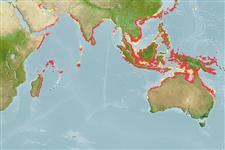Common names from other countries
>
Eupercaria/misc (Various families in series Eupercaria) >
Cepolidae (Bandfishes) > Cepolinae
Etymology: Acanthocepola: Greek, akantha = thorn + Latin, cepulla, cepa = onion.
More on author: Valenciennes.
Environment: milieu / climate zone / intervalo de profundidade / distribution range
Ecologia
marinhas bentopelágico; intervalo de profundidade 10 - 80 m (Ref. 127963). Tropical; 31°N - 29°S, 47°E - 155°E
Indo-West Pacific: Persian Gulf, Vietnam, Indonesia (Java to Flores and West Papua), Philippines, Papua New Guinea (Port Moresby to Milne Bay), and Australia (Queensland; Northern Territory and Western Australia).
Tamanho / Peso / Idade
Maturidade: Lm ? range ? - ? cm
Max length : 30.0 cm TL macho/indeterminado; (Ref. 11441)
Raios dorsais moles (total) : 69 - 80; Espinhos anais: 0 - 2; Raios anais moles: 70 - 84; Vértebras: 45 - 49. This species is characterized by the following: HL 6.3-8.4 in SL; preopercle with 5 blunt spines, the longest at angle. Colouration: head and body orange-pink with double series of yellow spots (smaller than pupil) on the sides; dorsal fin yellow-orange, anal fin yellow and median fins with narrow black margins; paired fins yellow with pink rays (Ref. 127963).
Cross section: oval.
Occurs in muddy habitats, usually in large colonies, each individual with its own burrow. Rises high above the substrate in schools to feed when plankton drifts over, typically in vertical posture (Ref. 48635).
Life cycle and mating behavior
Maturidade | Reprodução | Desova | Ovos | Fecundidade | Larvas
Kailola, P.J., 1987. The fishes of Papua New Guinea: a revised and annotated checklist. Vol. II Scorpaenidae to Callionymidae. Research Bulletin No. 41, Research Section, Dept. of Fisheries and Marine Resources, Papua New Guinea. (Ref. 6192)
Categoria na Lista Vermelha da IUCN (Ref. 130435: Version 2025-1)
Ameaça para o homem
Harmless
Utilização humana
Pescarias: bycatch
Ferramentas
Relatórios especiais
Descarregue XML
Fontes da internet
Estimates based on models
Preferred temperature (Ref.
123201): 25.6 - 29.1, mean 28.3 °C (based on 674 cells).
Phylogenetic diversity index (Ref.
82804): PD
50 = 0.5625 [Uniqueness, from 0.5 = low to 2.0 = high].
Bayesian length-weight: a=0.00339 (0.00183 - 0.00629), b=2.85 (2.67 - 3.03), in cm total length, based on LWR estimates for this species & (Sub)family-body (Ref.
93245).
Nível Trófico (Ref.
69278): 3.4 ±0.45 se; based on food items.
Resiliência (Ref.
120179): Elevada, tempo mínimo de duplicação da população menor que 15 meses (Preliminary K or Fecundity.).
Fishing Vulnerability (Ref.
59153): Low vulnerability (20 of 100).
🛈
